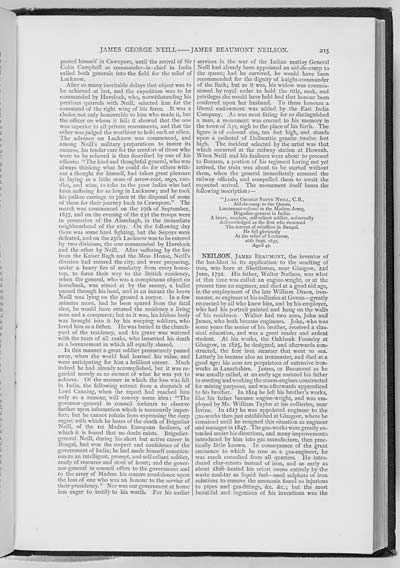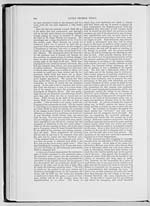Volume 3 > Half-Volume 5
(228) Page 215 - Neilson, James Beaumont
Download files
Individual page:
Thumbnail gallery: Grid view | List view

215 posted himself in Cawnpore, until the arrival of Sir Colin Campbell as commander-in-chief in India called both generals into the field for the relief of Lucknow. After so many inevitable delays that object was to be achieved at last, and the expedition was to be commanded by Havelock, who, notwithstanding his previous quarrels with Neill, selected him for the command of the right wing of his force. It was a choice not only honourable to him who made it, but the officer on whom it fell: it showed that the one was superior to all private resentments, and that the other was judged the worthiest to hold such an office. The advance on Lucknow was commenced, and among Neill's military preparations to insure its success, his tender care for the comfort of those who were to be relieved is thus described by one of his officers: "The kind and thoughtful general, who was always thinking what he could do for others with- out a thought for himself, had taken great pleasure in laying in a little store of arrow-root, sago, can- dles, and wine, to take to the poor ladies who had been suffering for so long in Lucknow; and he took his palkee carriage to place at the disposal of some of them for their journey back to Cawnpore." The march was commenced on the 19th of September, 1857, and on the evening of the 23d the troops were in possession of the Alumbagh, in the immediate neighbourhood of the city. On the following day there was some hard fighting, but the Sepoys were defeated, and on the 25th Lucknow was to be entered by two divisions, the one commanded by Havelock and the other by Neill. After suffering by the fire from the Kaiser Bagh and the Mess House, Neill's division had entered the city, and were preparing, under a heavy fire of musketry from every house- top, to force their way to the British residency, when the general, who was a conspicuous object on horseback, was aimed at by the enemy, a bullet passed through his head, and in an instant the brave Neill was lying on the ground a corpse. In a few minutes more, had he been spared from the fatal shot, he would have entered the residency a living man and a conqueror; but as it was, his lifeless body was brought into it by his weeping soldiers, who loved him as a father. He was buried in the church- yard of the residency, and his grave was watered with the tears of all ranks, who lamented his death as a bereavement in which all equally shared. In this manner a great soldier prematurely passed away, when the world had learned his value, and were anticipating for him a brilliant career. Much indeed he had already accomplished, but it was re- garded merely as an earnest of what he was yet to achieve. Of the manner in which the loss was felt in India, the following extract from a despatch of Lord Canning, when the report had reached him only as a rumour, will convey some idea; "The governor-general in council forbears to observe further upon information which is necessarily imper- fect; but he cannot refrain from expressing the deep regret with which he hears of the death of Brigadier Neill, of the 1st Madras European fusileers, of which it is feared that no doubt exists. Brigadier- general Neill, during his short but active career in Bengal, had won the respect and confidence of the government of India; he had made himself conspicu- ous as an intelligent, prompt, and self-reliant soldier, ready of resource and stout of heart; and the gover- nor-general in council offers to the government and to the army of Madras his sincere condolence upon the loss of one who was an honour to the service of their presidency." Nor was our government at home less eager to testify to his worth. For his earlier services in the war of the Indian mutiny General Neill had already been appointed an aid-de-camp to the queen; had he survived, he would have been recommended for the dignity of knight-commander of the Bath; but as it was, his widow was commis- sioned by royal order to hold the title, rank, and privileges she would have held had that honour been conferred upon her husband. To these honours a liberal endowment was added by the East India Company. As was most fitting for so distinguished a man, a monument was erected to his memory in the town of Ayr, nigh to the place of his birth. The figure is of colossal size, ten feet high, and stands upon a pedestal of Dalbeattie granite twelve feet high. The incident selected by the artist was that which occurred at the railway station at Howrah. When Neill and his fusileers were about to proceed to Benares, a portion of his regiment having not yet arrived, the train was about to be started without them, when the general immediately arrested the railway officials, and compelled them to await the expected arrival. The monument itself bears the following inscription:� "JAMES GEORGE SMITH NEILL, C.B., Aid-de-camp to the Queen, Lieutenant-colonel in the Madras Army, Brigadier-general in India: A brave, resolute, self-reliant soldier, universally Acknowledged as the first who stemmed The torrent of rebellion in BengaL He fell gloriously At the relief of Lucknow, z6th Sept. 1857, Aged 47. NEILSON, JAMES BEAUMONT, the inventor of the hot-blast in its application to the smelting of iron, was born at Shettleston, near Glasgow, 22d June, 1792. His father, Walter Neilson, was what at that time was called an engine-wright, or at the present time an engineer, and died at a good old age, in the employment of the late William Dixon, iron- master, as engineer at his collieries at Govan�greatly respected by all who knew him, and by his employer, who had his portrait painted and hung on the walls of his residence. Walter had two sons, John and James, who both became engineers. John, who was some years the senior of his brother, received a clas- sical education, and was a great reader and ardent student. At his works, the Oakbank Foundry at Glasgow, in 1825, he designed, and afterwards con- structed, the first iron steamer that went to sea. Latterly he became also an ironmaster, and died at a good age: his sons are proprietors of extensive iron- works in Lanarkshire. James, or Beaumont as he was usually called, at an early age assisted his father in erecting and working the steam-engines constructed for mining purposes, and was afterwards apprenticed to his brother. In 1814 he left his brother's works, like his father became engine-wright, and was em- ployed by Mr. William Taylor at his collieries, near Irvine. In 1817 he was appointed engineer to the gas-works then just established at Glasgow, where he remained until he resigned this situation as engineer and manager in 1847. The gas- works were greatly ex- tended under his directions, and many improvements introduced by him into gas manufacture, then prac- tically little known. In consequence of the great eminence to which he rose as a gas-engineer, he was much consulted from all quarters. He intro- duced clay-retorts instead of iron, and as early as about 1826 Cheated his retort ovens entirely by the waste coal-tar as liquid fuel�used sulphate of iron solutions to remove the ammonia found so injurious to pipes and gas-fittings, &c. &c.; but the most beautiful and ingenious of his inventions was the
Set display mode to:
![]() Universal Viewer |
Universal Viewer | ![]() Mirador |
Large image | Transcription
Mirador |
Large image | Transcription
Images and transcriptions on this page, including medium image downloads, may be used under the Creative Commons Attribution 4.0 International Licence unless otherwise stated. ![]()
| Biographical dictionary of eminent Scotsmen > Volume 3 > Half-Volume 5 > (228) Page 215 - Neilson, James Beaumont |
|---|
| Description | Spine title: Half-Vol. V. Macadam to Smith. |
|---|---|
| Description | Volume III. Contains names alphabetically from Macadam to Young. |
|---|

